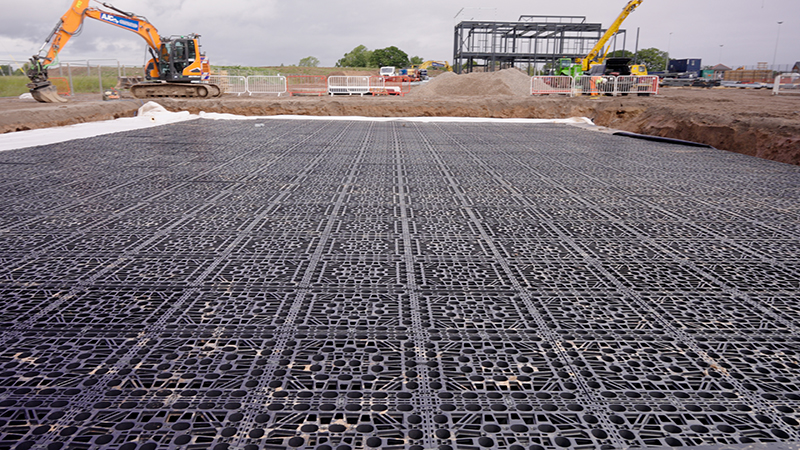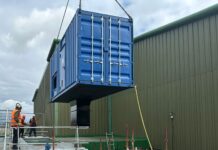
By Mark Caswell, technical manager for water management specialists Graf UK
CORRECT stormwater management is critical to urban planning and infrastructure development because it protects communities by safely and sustainably handling stormwater runoff. If done incorrectly, it will exacerbate rather than mitigate the issue.
So, stormwater system specifiers such as engineers and system managers face multiple challenges in managing stormwater systems effectively, at a time when unprecedented urban growth and changing rainfall patterns means effective stormwater solutions are more critical than ever.
Urbanisation, whether it is residential or commercial, is leading to the replacement of natural grass or soil areas with impervious surfaces such as roads and car parks, not to mention increasingly large buildings such as distribution warehouses.
Surfaces such as these prevent stormwater from infiltrating the ground, increasing the resulting runoff’s volume and velocity. More river surfaces lead to higher flood risk, erosion of river banks, and degradation of local water bodies.
Ways to reduce or offset the impact of impervious surfaces include retrofitting existing infrastructure, and reviewing site design considerations. Green infrastructure practices can include permeable paving, green roofs and rain gardens, which can be integrated into site designs to promote stormwater infiltration and reduce runoff.
Geocellular tanks are now a go-to method for surface water management. They are used to form an underground attenuation or infiltration system designed to store excess water in circumstances where heavy rainfall means the volume of water flowing from a site exceeds the allowable discharge rate.
Once the water exceeds the allowable discharge rate (for attenuation tanks) or the permeability rate of the surround soil (for infiltration tanks) it backs up in the tanks where it is stored until the storm event has declined and the flow rate of the water has decline sufficiently.
Their versatile design enables them to be used in configurations and applications across all construction environments, as a standalone solution or as part of an integrated sustainable drainage system (SuDS) scheme. They are used across virtually all types of projects, from housing developments and car parks though to retail sites.
But selecting the right system involves multiple important factors. Here are 10 key considerations:
1. Purpose and hydraulic design
Designers need to establish from the outset if an infiltration system is suitable. This allows the stormwater to percolate back into the ground as it would have done naturally and is usually the preferred option. The other is an attenuation tank which stores the water and discharges it into the drainage network at a controlled rate.
The design should consider runoff rates, discharge limits and future climate changes, elements that some manufacturers of stormwater systems can help with by providing UK/Ireland-specific volume calculations. The designer needs to factor in void ratios, silt control and pre-treatments like filters during this initial planning.
2. Site and ground conditions
A thorough site investigation should be carried out, including soil type clarification, to establish its strength parameters and permeability, groundwater levels and the topography of the site, as these can all have an impact on what system is needed.
3. Structural design and load class
When specifying the system, the structural loading the tank will be subjected to must be considered. The burial depth, amount of cover and the vehicle loading are critical to the choice of a suitable system. Construction loadings must also be taken into account as this is more often than not when the tank will be subjected to the greatest loading. These calculations are typically carried out automatically by reputable manufacturers.
4. Excavation and ground preparation
It is critical that the excavation and ground preparation are suitable both from a Health and Safety perspective and to offer a stable foundation to construct the tank on. It goes without saying that the sides of the excavation must be battered or stepped back to provide a safe environment for the installation team to work in. Where space or other site restrictions don’t allow for this then addition measures must be taken, such as sheet piling. CBR tests should be carried out to ensure the underlying ground is suitable to take the loads of the tank, with a CBR value of at least 5% typically required. Where this cannot be achieved with the native ground, then additional soil stabilisation methods need to be considered.
5. Infrastructure integration
Drainage systems must integrate cleanly with surrounding infrastructure to be effective, so inlet/outlets need to be aligned with existing pipework, flow gradients need to be maintained, and links with other SUDS systems considered all need to form part of the planning right from the start of the process. Again, manufacturers can provide site-specific drawings showing the installation of the tank and how its fits with the rest of the drainage elements.
6. Installation best practices
Manufacturers’ specifications are there because have designed and tested the product and know it best, so it’s vital this advice is followed. Ensure crates are installed as per their recommendations, using membranes and geotextiles that meet the required specification.
Follow best practice for joining membranes, with joints thermal wedge welded rather than taped. Then balance backfill compaction to avoid deformation. Reputable manufacturers provide full tank installations using CSWIP-trained and approved welders, providing expertise and experience to ensure reliable installations.
7. Access and maintenance
Geocellular tanks are not ‘fit and forget’ systems. Long-term access is essential so the specification at design stage of inspection voids or corridors, silt traps/catchpit manholes and upstream filters to reduce cleaning are essential, as are integral shafts within the tank providing access for inspection and maintenance. Inspectable crates and integral access chambers are offered by some manufacturers to ease this process.
8. SuDS and regulatory compliance
Designers should ensure that systems meet all relevant requirements set by local, regional, national or international bodies. These range from Local Lead Flood Authority (LLFA) requirements, water company adoption criteria, and water quality requirements to CIRIA’s SuDS Manual and Building Regulations. BBA accreditation is an added bonus as this shows the system has been independently tested and the result stated verified.
9. Modularity and logistics
Modular crates improve efficiency in a number of areas. Stackable crates save on transport costs and on-site storage space, while a quick-fit design reduces installation time. They are lightweight and can be easily lifted and installed without manual handling issues or the need for lifting machinery.
10. Long-term reliability and supplier support
Even with the benefit of long-term access, long-term reliability will give the system owners peace of mind. Choosing a supplier who can provide strong technical support with the system design and installation, along with site-specific calculations and drawings, is essential.
An installation warranty, handover (OEM) pack and ongoing maintenance guidance should also be provided by whoever is installing the system.
A comprehensive website, with case studies and downloadable technical documentation, can also be backed up by remote and in-person site-specific support.









